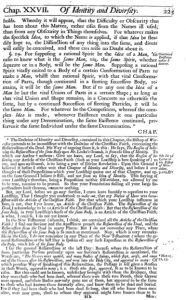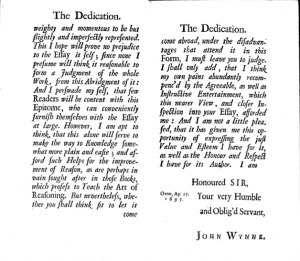Locke’s Essay was first published in 1689. The book I am looking at is the seventh edition. There must be quite a few changes from the Essay‘s publication in 1689 to the edition I am looking at. We can draw out the changes in terms of changes on the ‘outside’ and changes on the ‘inside’.
It is going to be hard to answer how the book has changed on the outside without having access to physical copies of all the editions. I do have one thing to offer:
The first edition was a folio, as the ESTC states; however, my edition is smaller and is an octavo. The first time the Essay became an octavo was the sixth edition published in 1710 by the Churchills. The move from a folio to an octavo was probably to be able to make the book more portable to help boost sales. Other than this, I cannot offer more information about how the book has changed on the outside over its various editions.
The inside of the book though is easier to research. The ‘Dedication’ and the ‘Epistle’ that we saw in our edition has been a part of previous editions, including the one from 1690:
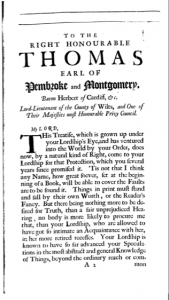 The ‘Dedication’ from the first edition, off EEBO
The ‘Dedication’ from the first edition, off EEBO
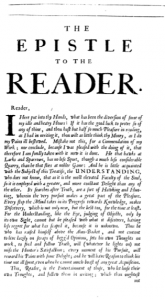 The ‘Epistle’ from the same edition
The ‘Epistle’ from the same edition
You can see that the image makes it look like the pages are huge. It is because the image is from a folio edition.
Coming back to all those questions I left you with at the end of the previous post: When did the editorship begin?
Below is an image from the first edition against the same page from my edition:
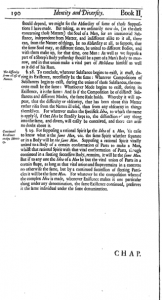
 Clearly scholarly editing did not occur in the first edition.
Clearly scholarly editing did not occur in the first edition.
After some research on EEBO, which involved looking through each of the editions, I found that the Churchill edition was the first one to do this editing. More specifically it was the fifth edition where the changes first appeared:
The footnote refers to one of Locke’s letters wherein he clarifies the issue of how the idea ‘of identity and diversity’ is not inconsistent with the Christian Doctrine . Therefore, it is not like the editor is carrying out any of his own analysis. Moreover, the Biography entry of Locke states, “…Locke was on friendly terms with the printers (Awnsham and John Churchill)…”. I, hence, do not think that the changes were made without Locke’s consent.
I should also speak a little about An Abridgement of Mr. Locke’s Essay Concerning Human Understanding, which was first published by the Churchills in 1696. This was not written by Locke, but rather by John Wynne.
John Wynne was the Bishop of Bath and Wells. He wrote the Abridgement, “…which he hoped would bring the ‘Vulgar Systems’ prevalent at Oxford into discredit” (Oxford Dictionary of National Biography). The Abridgement was approved by Locke before it was published by the Churchills. Moreover, the Abridgement went through eleven edition by 1774.
So far I have given you a lot of information. Now I am going to start trying to make sense of all this information in an effort to answer why the book was so popular.
